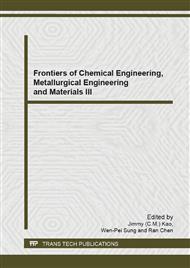p.428
p.433
p.438
p.442
p.446
p.450
p.454
p.457
p.461
Understanding and Assessment of Ancient Chinese Pig Blood–Lime Mortar
Abstract:
Pig blood-lime mortar is one of the most representative formulations among the ancient Chinese organic-inorganic mortars. It was used primarily as binding material, lacquer and the ground layer of decorative oil paintings due to its good mechanical and waterproof preformance. Mortar in this work was fabricated according to the formulas of the ancient literature, and the mechanism of interaction between the key components of ancient mortar binding materials was analyzed via X-ray diffractometry. Results show that pig blood accelerates the formation of microstructure at early stage. A mechanism was suggested that biomineralization occurs during the carbonation of calcium hydroxide, where the pig blood functions as a template and controls the growth of calcium carbonate crystal.
Info:
Periodical:
Pages:
446-449
Citation:
Online since:
August 2014
Authors:
Keywords:
Price:
Сopyright:
© 2014 Trans Tech Publications Ltd. All Rights Reserved
Share:
Citation:


